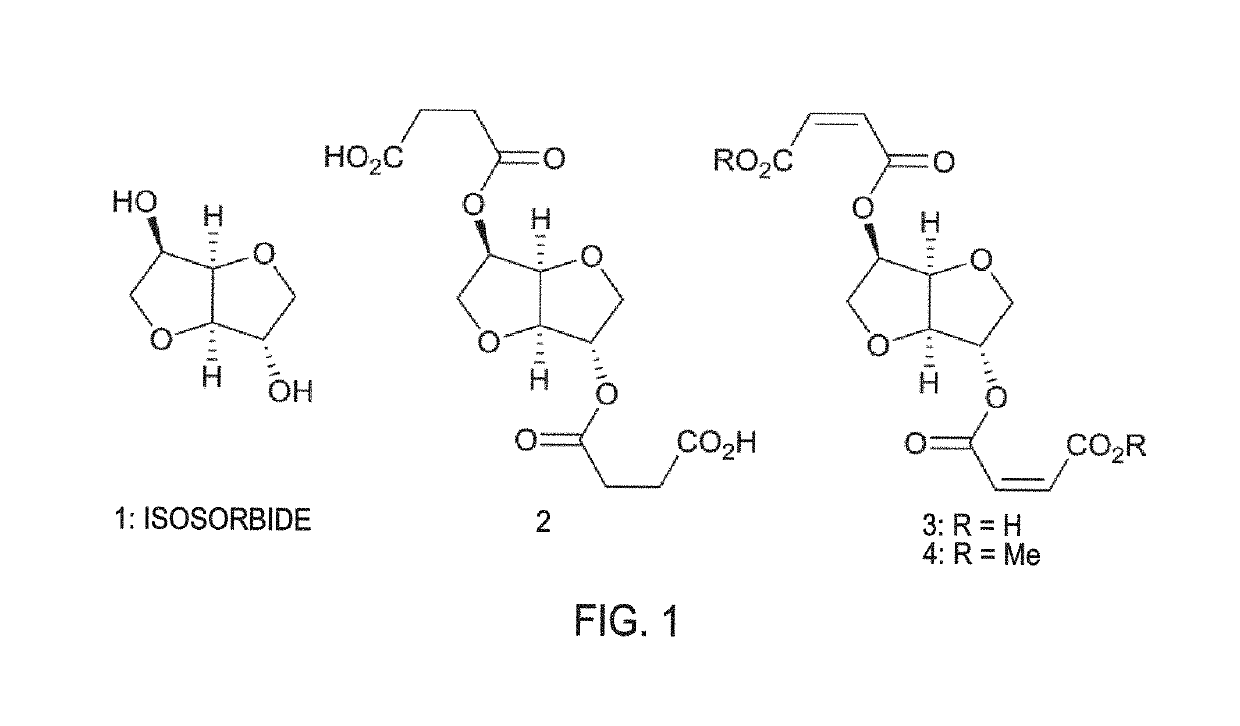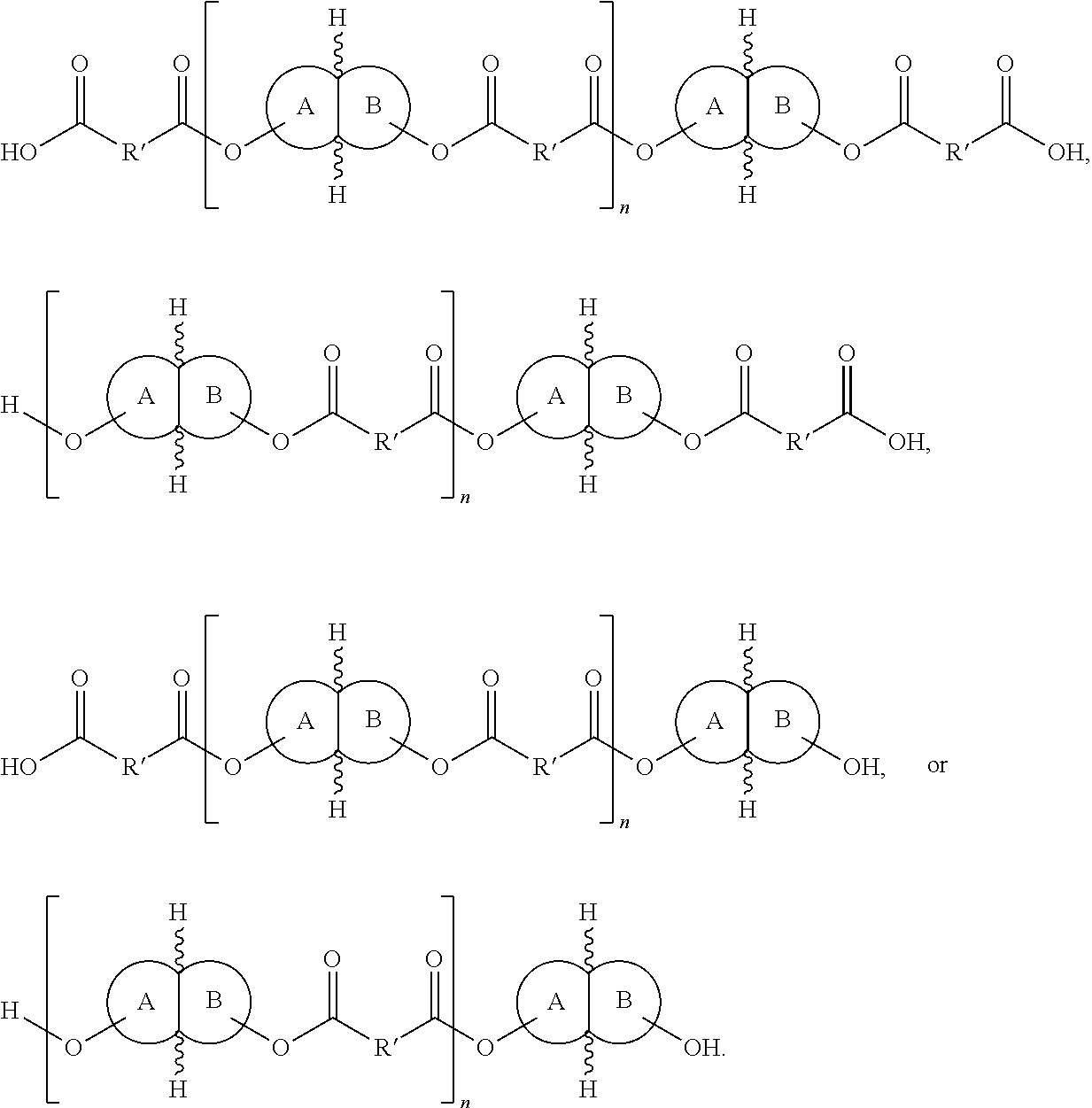Polymers and methods of making the same
a polymer and polymer technology, applied in the field of polymer formation, can solve the problems of high cost of tackifiers and often the most costly components of adhesive formulations, and achieve the effects of less or no purification, easy adjustment or tuning, and greater tackiness
- Summary
- Abstract
- Description
- Claims
- Application Information
AI Technical Summary
Benefits of technology
Problems solved by technology
Method used
Image
Examples
example 1
Synthesis of Polymers
[0142]FIG. 1 illustrates isosorbide (1) and three isosorbide-based tackifiers (2-4). Thermal polymerization of diacid 3 (not purified) and dimethyl ester 4 (purified) was conducted on 5 gram scale in a 20 mL vial open to air. The start of the reaction (t=0) was defined as the time when steady magnetic stirring at 650 rpm was first achieved.
[0143]The polymerizations of diacid 3 and dimethyl ester 4 were conducted at the lowest temperatures which yielded complete polymerization (gauged visually) after 24 hours. Interestingly, methyl ester 4 was much slower to polymerize than diacid 3; diacid 3 polymerized at 180° C., but methyl ester 4 required 230° C. Furthermore, the physical appearance of the resultant polymers also differed significantly. Whereas diacid 3 polymerized to give a light-colored solid with an uneven surface (5, initially-proposed structure; see FIG. 2a, illustrating proposed free-radical polymerization products of 3 and 4), methyl ester 4 polymeriz...
example 2
NMR Spectroscopy
[0145]1H NMR spectroscopy was used to characterize the polymerization pathways. Aliquots of a polymerization of diacid 3 were obtained at time points from 0 minutes to 120 minutes (see FIG. 3, illustrating time-dependent 1H NMR spectra of the polymerization of diacid 3). The end point of 120 minutes was chosen because aliquots obtained at later time points did not fully dissolve in DMSO.
[0146]It was determined from a phase-edited HSQC spectrum that although multiple isosorbide-containing species were present, one of the hydrogens at the ring fusion was always found in a narrow chemical shift range (4.56 to 4.30 ppm). No other hydrogens were observed in this region of the spectrum, and therefore the integration of this region corresponded to the isosorbide content of the sample. By analyzing both unreacted diacid 3 and a sample of diacid 3 that had been heated for 120 minutes in the presence of an internal standard (N,N-dimethylformamide), it was further determined th...
example 3
IR Spectroscopy and Rheology
[0149]Since 1H NMR spectroscopy suggested an unexpected polymerization pathway for diacid 3, IR spectroscopy and rheology were used for further verification of this result. IR spectra of selected aliquots (see, FIG. 8, illustrating time-dependent IR spectra during the polymerization of diacid 3, in accordance with various embodiments) provided additional evidence for the polymerization pathway outlined in FIG. 2a. Initially the IR spectrum showed predominantly intramolecular hydrogen bonding consistent with maleate mono-acids. A strong hydroxyl stretch consistent with free alcohols quickly appeared. This new stretch reduced in intensity after 30 minutes, but did not completely disappear because the oligomeric material present after 120 minutes of heating contained some fumarate mono-acids.
[0150]The polymerization of diacid 3 was also followed by dynamic rheology (see, FIG. 9, illustrating time-dependent complex viscosity (η*), storage modulus (G′), and lo...
PUM
| Property | Measurement | Unit |
|---|---|---|
| glass transition temperature | aaaaa | aaaaa |
| temperatures | aaaaa | aaaaa |
| wt % | aaaaa | aaaaa |
Abstract
Description
Claims
Application Information
 Login to View More
Login to View More - R&D
- Intellectual Property
- Life Sciences
- Materials
- Tech Scout
- Unparalleled Data Quality
- Higher Quality Content
- 60% Fewer Hallucinations
Browse by: Latest US Patents, China's latest patents, Technical Efficacy Thesaurus, Application Domain, Technology Topic, Popular Technical Reports.
© 2025 PatSnap. All rights reserved.Legal|Privacy policy|Modern Slavery Act Transparency Statement|Sitemap|About US| Contact US: help@patsnap.com



